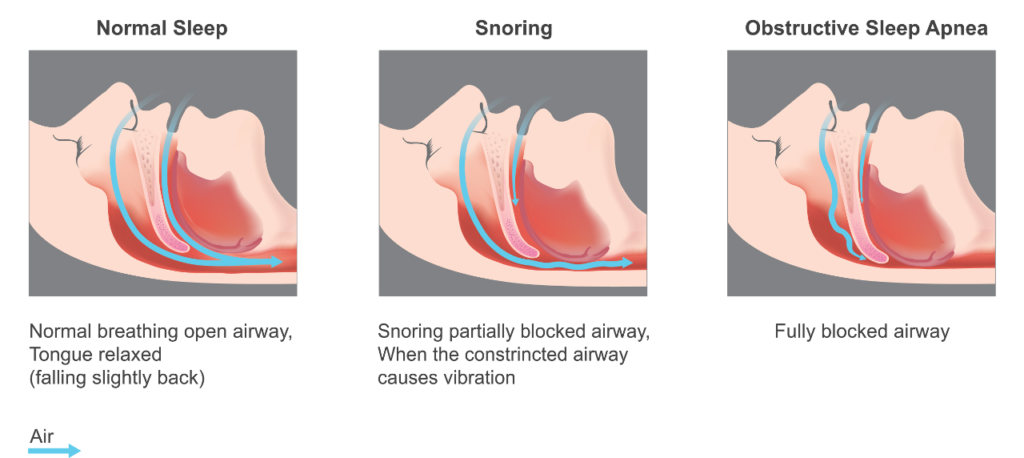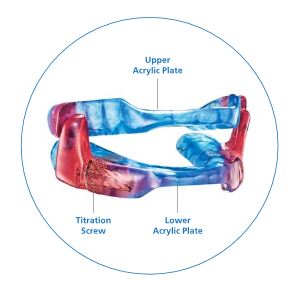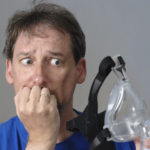You may not realize, or be bothered by it, but you probably snore. Studies show an estimated 30% to 50% of the U.S. population experiences snoring. While it may not appear to affect the snoring person, there are many benefits to stop snoring. A partner’s snoring can create a large amount of stress on a relationship. In addition to affecting their relationship, people who snore significantly may also have a deeper condition, called Obstructive Sleep Apnea. With OSA, a person repeatedly stops breathing during their sleep which can impact other aspects of life, from feeling tired throughout the day, to irritability and depression.
All snoring does not indicate sleep apnea
Just because you snore, that does not automatically indicate the presence of obstructive sleep apnea. To determine whether snoring indicates OSA, consider whether these sleep apnea symptoms are present:
- Pauses that take place while snoring
- Choking or gasping that follows the pauses
- Fighting sleepiness at work, when driving, or during the entire day
- Rapidly falling asleep when inactive
- Morning headaches
- Irritability
- Depression
- Personality changes or mood swings
- Sore throat or dry mouth after waking up
- Hypertension, acid reflux, and weight gain
- Breathing cessation episodes
- Attention problems
- Difficulty staying asleep at night
- Decreased libido
How does Obstructive Sleep Apnea occur?
When Obstructive Sleep Apnea occurs, the tongue and soft palate collapse onto the back of the throat and block the airway which restricts the flow of oxygen. If you have a large tongue or a small jaw, there is a higher chance that you could suffer from OSA.

How do dental devices work for Obstructive Sleep Apnea?
Oral Sleep Appliances are specific dental devices that you wear during sleep. It prevents the lower jaw and tongue from relaxing and collapsing, thereby keeping open the airway, allowing for smoother breathing.
Dental devices that help in treating sleep apnea

Image courtesy of Respire Medical
One way to treat excessive snoring and sleep apnea is to use an Oral Sleep Appliance. These appliances are useful in correcting mild to moderate cases of obstructive sleep apnea. There are numerous options for these dental devices, and a dentist will recommend one that suits the individual’s particular needs and ensures it fits in the safest way.
One of the most widely used dental appliances for the treatment of sleep apnea is the mandibular advancement device. It resembles a sports mouth guard in appearance and is useful in forcing the lower jaw down and forward slightly. This helps to keep the airway open, thereby preventing problems in breathing.
Can I use an OSA Dental Device instead of CPAP?
If you have mild to moderate Obstructive Sleep Apnea (OSA), an OSA Dental Device is one treatment option. If you have severe OSA, the primary treatment is CPAP. But if you are intolerant to or not successful with CPAP treatment, an alternative option to consider is a dental device.
Benefits of Oral Sleep Appliances for the treatment of sleep apnea
 There are numerous reasons why dental professionals recommend dental devices to people with sleep apnea. One is that these are effective in improving the airflow of those who suffer from severe apnea. The appliances are proven to be extremely effective in significantly reducing mild to moderate cases of apnea. The devices are also particularly useful for those who either sleep on their stomach or back. Dental appliances also provide the benefits of improved sleep patterns, reduced frequency of snoring, reduced loudness of snoring, and have high success rates. Finally a Oral Sleep Appliance may be recommended in place of a CPAP machine, as it is less constricting for people who are uncomfortable wearing the mask. A CPAP machine is not silent either, so the oral sleep appliance may be preferred by your partner if they are a light sleeper.
There are numerous reasons why dental professionals recommend dental devices to people with sleep apnea. One is that these are effective in improving the airflow of those who suffer from severe apnea. The appliances are proven to be extremely effective in significantly reducing mild to moderate cases of apnea. The devices are also particularly useful for those who either sleep on their stomach or back. Dental appliances also provide the benefits of improved sleep patterns, reduced frequency of snoring, reduced loudness of snoring, and have high success rates. Finally a Oral Sleep Appliance may be recommended in place of a CPAP machine, as it is less constricting for people who are uncomfortable wearing the mask. A CPAP machine is not silent either, so the oral sleep appliance may be preferred by your partner if they are a light sleeper.
How do I know if my insurance covers the cost of an OSA Dental Device?
These dental devices are considered medical devices and are accepted under most medical insurance and Medicare. Please talk with your dentist to verify insurance coverage information.

